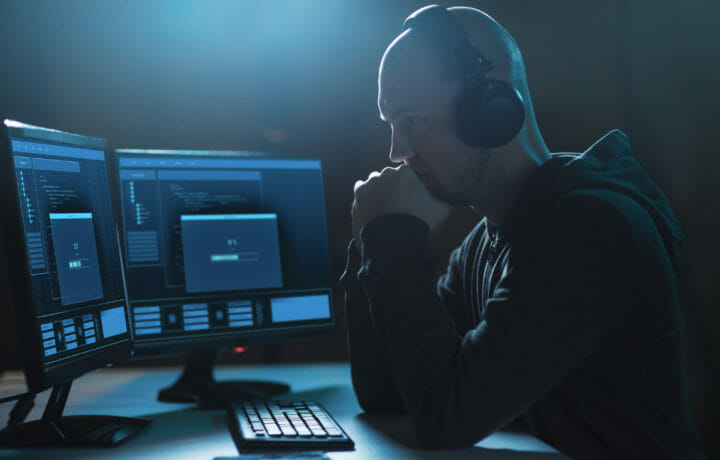Following the September 11, 2001 terrorist attacks on the World Trade Center and Pentagon, the National Security Agency (NSA) was authorized to monitor – without obtaining a FISA warrant – the phone calls, internet activity, text messages and other communications involving any party believed by the NSA to be outside the U.S., even if the person(s) on the other end of the communication was in the country. In April 2009, officials at the Department of Justice (DoJ), which had long defended the practice, acknowledged that there was an “over collection” of domestic communications.
For Brian Hochman, associate professor of English at Georgetown University, that is actually where the story of wiretapping actually ends. Hochman spent eight years working on the history of communications surveillance, and he received support from the National Endowment for the Humanities Public Scholars Program and the Library of Congress Kluge Center. The Listeners: A History of Wiretapping in the United States will be released in March from the Harvard University Press.
This new history of wiretapping reveals not only the how but the why, chronicling how telegraph operators intercepted enemy message during the American Civil War, while law enforcement agencies began listening to private telephone calls as early as 1895.
It took far longer for laws to catch up.
“Individual states passed laws about tapping telegraph and telephone lines, and California was the first,” Hochman told ClearanceJobs. “However, there wasn’t really any federal statue until 1968.”
Laws Lag Behind Technology
Wiretapping is a classic example of legislation lagging behind technological advancement, and regulations have long continued to play a game of catch-up.
“The lag was the product of unique political arrangements,” explained Hochman. “Technology had always been faster than the law, but politics played an important role in the relationship.”
For years, the technology wasn’t even all that sophisticated. The interception of communication, first by telegraph and then by the telephone, actually remained relatively stable until the rise of cellular and mobile communications beginning in the 1980s and continuing to this day.
Even when legislation caught up with wiretap, efforts were made to get around the laws.
One such example was induction wiretaps.
“It was basically a wireless wiretap, which could be used to pick up conversation without making a physical connection,” described Hochman. “There was a great deal of proliferation of induction wiretapping, which used induction coils that could be placed near a phone, in the 1930s.”
It proved to be a workaround where state statues had criminalized wiretapping that involved a physical connection.
“If you’re not connecting to a live connection, than the perception was that it wasn’t really wiretapping,” added Hochman.
Understating Title 3
Key to wiretapping today is the Federal Wiretap Act, 18 U.S.C. §§ 2510‐2522, better known as “Title III,” of the Omnibus Crime Control and Safe Streets Act, which Hochman notes in his book was a major piece of wiretap legislation designed to protect the “privacy of innocent persons” while legalizing police wiretapping under judicial supervision.
Title III prohibits the interception and disclosure of wire, oral and electronic communications, as well as the manufacture, distribution and possession of such interception devices, 18 U.S.C. §§ 2511‐15. However, Title III expressly authorizes federal and state government authorities in certain criminal investigations to intercept, disclose, and use such communications, which include e‐mails, faxes and pager numbers, as well as telephone calls.
However, Title III expressly does not apply to consensual recordings, including instances where a cooperating witness voluntarily records her own telephone calls.
“Americans have been complaining about the end of privacy since the beginning of privacy,” Hochman told ClearanceJobs. “We only think about when they lose them. What is different today is the scale that of loss is more readily felt.”
Acceptance of Wiretapping
In the post-9/11 era – especially after the disclosure of programs such as the one run by the NSA, it is clear many Americans disapprove of overzealous wiretapping. But this is hardly new. Prior to the 1960s, tapping of a telephone was seen as an egregious activity.
“There was a massive shift, where it went from something done by dirty cops to a legitimate effort to address rising crime rates and to clean up the streets,” said Hochman. “What is also interesting is that both political extremes have spoken out against it. On the right conservatives have worried about wiretaps of state overreach, while liberals worry about it impacts civil liberties.”
Even today, as wiretapping is seen as a justifiable tool of law enforcement that needs to have clear boundaries, there is a real concern that technology could outpace not only the laws, but efforts by law enforcement to legally monitor certain communications.
“Technology is creating new challenges,” said Hochman. “But the FBI still found a way to monitor Skype or communications in video games. The regulatory apparatus has provided the tools for law enforcement to listen in, and has compelled tech firms to comply with law enforcement.”
Chief among these was the Communications Assistance for Law Enforcement Act (CALEA), also known as the “Digital Telephony Act,” which was passed in 1994.
“It required telecommunication carriers to have surveillance methods built into the networks and devices,” said Hochman. “It didn’t have jurisdiction over the Internet, but the principle has remained similar with ‘limited assistance’ being provided.”
While the book ends with the changed world following the 9/11 attacks, it presents an excellent road map that shows the route we took to get to that point. And today as our smart TVs have been reported to have spied on us, and we regularly talk to our digital assistances, we may want to ponder, “Who is listening?”



